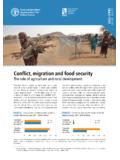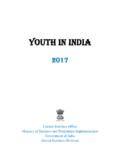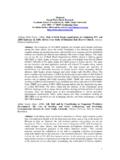Transcription of Is this humanitarian migration crisis different? - …
1 migration Policy Debates OECD, N 7 September 2015 1 The current humanitarian crisis is unprecedented with an appalling and unacceptable human cost. The number of refugees is unparalleled in recent times. The diversity of nationalities, motives for migration and individual profiles also creates a huge challenge for asylum systems and welcoming communities in main European destination countries. Moreover, given the complexity of its main driving forces, there is unfortunately little hope that the situation will improve significantly in the near future. This issue of migration Policy Debates looks at the most recent developments in the humanitarian migration crisis and what makes this crisis different from previous ones.
2 _____ Is this humanitarian migration crisis different ? Europe will record in 2015 an unprecedented number of asylum seekers and refugees with up to one million asylum applications; an estimated 350 000 to 450 000 people could be granted refugee or similar status, more than in any previous European refugee crisis since World War II. In recent months the Eastern Mediterranean and Western Balkan routes have gained importance with relatively large numbers of people starting to leave or transit via Turkey. The Central Mediterranean route, which leads to Italy, also continued to be heavily used.
3 According to the latest available estimates more than 330 000 persons have arrived by sea in Europe since January this year, including about 210 000 landings in Greece and 120 000 in Italy. As during previous refugee crises in the 1990s the impact is concentrated in a few countries. In the OECD, Turkey is the most affected, currently hosting as many as million Syrians as well as a large number of people from Iraq. Within the EU, Italy, Greece and Hungary are on the front line but the main destination countries are Germany, in absolute terms, and Sweden and Austria, relative to their population. More than in previous crises, asylum seekers are very diverse in terms of country of origin, profile and motivation.
4 This increases the pressure on asylum systems in destination countries. Recent refugees from the Syrian Arab Republic (Syria) are more skilled than other groups and those who came, for example, during the Yugoslav wars in the 1990s. There are more unaccompanied minors (children without a responsible adult to care for them) arriving now than previously. Refugee flows tend to concentrate in countries with the most favourable economic conditions. A strong jobs market seems to be the most important determinant of flows for main refugee groups. Europe has better legal and institutional systems in place for asylum-seekers and migrants than it did in the 1990s.
5 However, these have not ensured a fair burden-sharing between countries, and have not prevented people from choosing smuggling routes. In the current emergency situation, several countries are struggling to welcome, assist and process very large number of incoming people. Some regions and localities are under intense pressure. Coordination between different levels of governance will be key to prevent local communities from being overwhelmed. Since the 1990s, many EU countries have developed better settlement services for refugees which should help to cope in the medium term. For several EU countries, large-scale asylum inflows are a new experience.
6 This is the case, for example, for Hungary and to a lesser extent for Poland and Bulgaria. Financial and technical support from other EU countries and from EU institutions is critical to enable them to respond to the emergency. In the short run, processing and supporting such large numbers of asylum seekers will be costly. In the long-run, much will depend on how well successful asylum seekers are integrated. This will require early and intensive efforts to provide language training, assess individual skills, provide school access, address health and social problems, and work with employers to help boost refugees chances of employment.
7 Past experience of refugee crises suggests that migrants can, eventually, become valued and valuable contributors to the economic and social health of countries. N 7, September 2015 migration Policy Debates OECD, N 7 September 2015 2 The unfolding humanitarian crisis : how does it compare with previous ones? The refugee crisis in E urope is unprecedented in terms of the numbe r of people involved .. In 2014, 630 000 asylum requests were registered in EU member countries, a number last reached during the conflict between Bosnia and Serbia in 1992. According to most recent available data, up to 700 000 asylum applications have been already filed so far this year1, and the number could reach 1million by the end of the year.
8 Between 350 000 and 450 000 people could be granted humanitarian protection in Europe in 2015 (refugee status, subsidiary protection status, or permission to stay for humanitarian reasons). Fig 1. Number of new asylum seekers 1980-2014 in the OECD, the EU and Germany Source: UNHCR. In Europe, most people who seek asylum have entered through illegal border crossings. According to Frontex data for the first eight months of 2015, 500 000 illegal border crossings were detected, compared with 280 000 for all of 2014. More than 330 000 people have crossed the Mediterranean this year already. According to UNHCR data, 15% of them were children and more than 80% of the adults were men2.
9 With new migration routes emerging Through 2015 and in particular during the summer, not only inflows surged but the routes used by asylum seekers also changed. The Eastern Mediterranean and Western Balkan route , which is mainly used by asylum seekers from Syria, Iraq and Afghanistan, has been more frequently used, including by Pakistani and selected African migrant groups as well as by people leaving the Western Balkans territories themselves. In the first half of 2015, 66 000 people crossed the Mediterranean between Turkey and Greece and more than 137 000 people more did so in July and August.
10 Many of them headed to Hungary, where illegal border entries consequently spiked3. This route is also largely used by families with children. This corridor may remain heavily used in the future unless Eastern border routes partly substitute. Not everyone arrives directly from their home country. About 2 million Syrians, mostly under temporary protection status, are estimated to be currently in Turkey. Another 300 000 persons, mainly from Afghanistan, Iraq and Pakistan, are residing unlawfully in Turkey while waiting to transit to seek refuge in the EU. More than million Syrians are currently in Lebanon where the situation is increasingly unstable.

















